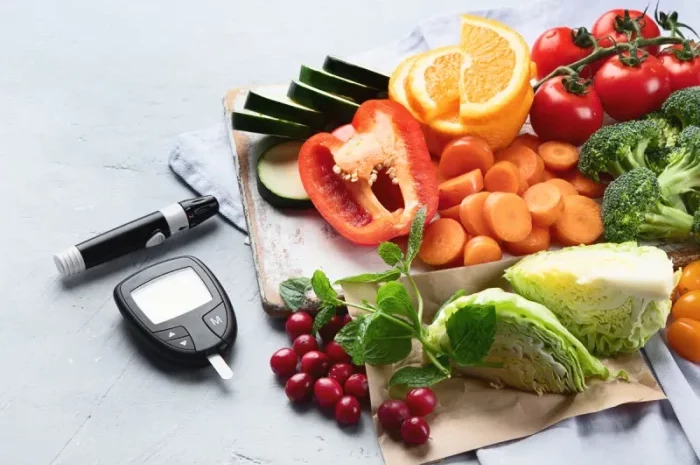Introduction
Diabetes, a chronic metabolic disorder characterized by elevated blood glucose levels, requires vigilant management to prevent complications and maintain overall health. While medications play a crucial role in controlling blood sugar, diet remains a cornerstone of diabetes management. With the right dietary choices, individuals can effectively regulate their blood glucose levels and reduce the risk of complications. In this comprehensive guide, we will explore the relationship between diet and blood glucose levels, and provide practical recommendations on foods to incorporate into a diabetes-friendly diet.
Understanding Blood Glucose Regulation
Before delving into dietary recommendations, it’s essential to understand how the body regulates blood glucose levels. When you consume food, especially carbohydrates, your digestive system breaks it down into glucose, which enters the bloodstream. In response, the pancreas releases insulin, a hormone that helps cells absorb glucose for energy or storage. In individuals with diabetes, this process is disrupted:
- Type 1 diabetes: The pancreas produces little to no insulin, requiring insulin injections for glucose regulation.
- Type 2 diabetes: Cells become resistant to insulin or the pancreas doesn’t produce enough insulin, leading to elevated blood glucose levels.
Managing blood glucose levels involves maintaining a delicate balance between food intake, physical activity, medication, and insulin therapy. Diet plays a pivotal role as certain foods can cause rapid spikes or dips in blood sugar levels.
The Diabetes-Friendly Diet
A diabetes-friendly diet focuses on controlling carbohydrate intake, choosing nutrient-dense foods, and maintaining consistent meal timing. The following dietary principles can help individuals with diabetes manage their blood glucose levels effectively:
- Carbohydrate Control: Carbohydrates have the most significant impact on blood glucose levels, making carbohydrate control a key aspect of diabetes management. Instead of eliminating carbs entirely, focus on consuming complex carbohydrates with a lower glycemic index (GI), which cause a slower and more gradual increase in blood sugar levels. Examples of low-GI carbohydrates include whole grains, legumes, vegetables, and fruits such as berries.
- Portion Management: Controlling portion sizes is crucial for managing blood glucose levels and preventing overeating. Use measuring cups, food scales, or visual cues to ensure appropriate portion sizes. Aim for balanced meals that include a mix of carbohydrates, lean protein, and healthy fats to promote satiety and stable blood sugar levels.
- Choose Fiber-Rich Foods: Dietary fiber slows down the absorption of glucose, helping to prevent rapid spikes in blood sugar levels. Incorporate fiber-rich foods such as fruits, vegetables, whole grains, legumes, nuts, and seeds into your meals and snacks. Aim for at least 25-30 grams of fiber per day, gradually increasing fiber intake to avoid digestive discomfort.
- Prioritize Lean Protein: Including lean protein sources in your meals can help regulate blood sugar levels and promote feelings of fullness. Choose lean protein options such as skinless poultry, fish, tofu, legumes, eggs, and low-fat dairy products. Avoid fried or heavily processed protein sources, which may contain added sugars or unhealthy fats.
- Healthy Fat Choices: While fat doesn’t directly impact blood glucose levels, it plays a role in overall health and satiety. Choose heart-healthy fats such as avocados, nuts, seeds, olive oil, and fatty fish like salmon and mackerel. Limit saturated and trans fats found in fried foods, processed snacks, and fatty cuts of meat, as they can contribute to insulin resistance and cardiovascular risk.
- Limit Added Sugars and Refined Carbohydrates: Minimize your intake of foods and beverages high in added sugars and refined carbohydrates, as they can cause rapid spikes in blood glucose levels. Avoid sugary drinks, desserts, candies, pastries, white bread, and sugary cereals. Opt for healthier alternatives such as whole fruits, unsweetened beverages, and whole grain products.
- Stay Hydrated: Proper hydration is essential for overall health and can support blood sugar management. Choose water as your primary beverage and limit intake of sugary drinks and alcohol, which can contribute to blood sugar fluctuations and dehydration.
- Mindful Eating Practices: Practicing mindful eating can help you better understand hunger cues, prevent overeating, and make healthier food choices. Slow down during meals, savor each bite, and pay attention to feelings of hunger and fullness. Avoid distractions such as television or smartphones while eating, as they can lead to mindless eating.
- Consistent Meal Timing: Aim for regular meal timing and spacing throughout the day to help stabilize blood sugar levels. Skipping meals or going long periods without eating can lead to blood sugar fluctuations and overeating later in the day. Plan ahead and have healthy snacks available to prevent dips in blood glucose levels between meals.
- Monitor Blood Glucose Levels: Regular monitoring of blood glucose levels is essential for understanding how different foods and lifestyle factors affect your diabetes management. Work with your healthcare provider to establish target blood glucose ranges and develop a monitoring schedule that fits your needs. Keep a food diary to track your dietary intake and identify patterns that may impact blood sugar control.
Sample Diabetes-Friendly Meal Plan
Here’s a sample meal plan that incorporates the principles of a diabetes-friendly diet:
- Breakfast: Spinach and mushroom omelet with whole grain toast and avocado slices.
- Mid-Morning Snack: Greek yogurt with berries and a sprinkle of nuts.
- Lunch: Grilled chicken salad with mixed greens, cherry tomatoes, cucumbers, and vinaigrette dressing.
- Afternoon Snack: Carrot sticks with hummus.
- Dinner: Baked salmon with quinoa pilaf and steamed broccoli.
- Evening Snack: Sliced apple with almond butter.
Conclusion
Managing blood glucose levels through diet is a fundamental aspect of diabetes management. By following a diabetes-friendly diet that emphasizes carbohydrate control, portion management, and nutrient-dense foods, individuals with diabetes can achieve better blood sugar control and improve overall health outcomes. It’s essential to work with a healthcare provider or registered dietitian to develop a personalized meal plan that meets individual needs and preferences. With mindful eating practices, regular physical activity, and medication management, individuals with diabetes can live well and reduce the risk of complications associated with uncontrolled blood glucose levels.
Related topics:
























